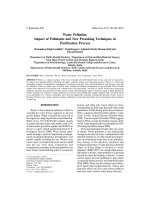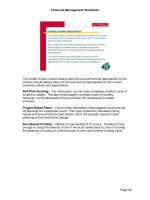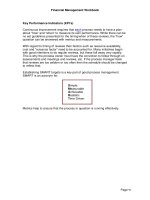PROJECT TIME PLANNING PROCESS AND BAR CHART TECHNIQUE
Bạn đang xem bản rút gọn của tài liệu. Xem và tải ngay bản đầy đủ của tài liệu tại đây (8.12 MB, 37 trang )
<span class="text_page_counter">Trang 1</span><div class="page_container" data-page="1">
<b>PROJECT TIME PLANNING </b>
<b>Process and Bar Chart Technique </b>
</div><span class="text_page_counter">Trang 2</span><div class="page_container" data-page="2">
Planning is the process of thinking systematically about the future in order to decidepreparations, and deciding the best course of action.
</div><span class="text_page_counter">Trang 3</span><div class="page_container" data-page="3"><b>Dimensions of Planning </b>
<b>Planning can be viewed from following points: </b>
<b>Subject</b>
<small>:- </small> <b><small>Time Planning, Quality Planning, Financial Planning, Risk Planning, Product Planning, Organizational </small></b></div><span class="text_page_counter">Trang 4</span><div class="page_container" data-page="4"><b>Why is TimePlanning necessary? </b>
1) <small>The increasing importance of </small><b><small>timely completion</small></b><small>. </small>
2) <small>The continuous complexity and growth in the size of the project generates the necessity for specialization. Specialization may </small>
<small>lead to a breakdown of communications. Time planning must be </small>
<small>found </small><b><small>to facilitate communications</small></b><small>. </small>
3) <small>Planning is essential for </small><b><small>resource management </small></b>
4) <small>Planning is important for the efficient and maximum </small><b><small>utilization of resources</small></b><small>. </small>
</div><span class="text_page_counter">Trang 5</span><div class="page_container" data-page="5">5) <small>Planning is basis for evaluating progress, </small><b><small>controlling </small></b> <small>the work and making decisions. </small>
6) <small>For achieving an </small><b><small>increase in production</small></b><small>. </small>
<b>7)<small>Financiers </small></b><small>require a workable plan. </small>
8) <small>Essential in projects when their is </small><b><small>transfer of personnel</small></b><small>. </small>
9) <b><small> Minimum risk </small></b><small>of the problems occurring. </small>
</div><span class="text_page_counter">Trang 6</span><div class="page_container" data-page="6"><b>Who Needs Time Planning? </b>
<small>Customer/ Client/ Owner </small>
<small>Designer/ Consultant </small>
<small>Project management team (Manager, Engineers) </small>
<small>Cost estimating department </small>
<small>Planning and controlling department </small>
<small>Supervisors, foremen, labors </small>
<small>Supplier </small>
<small>Financiers </small></div><span class="text_page_counter">Trang 7</span><div class="page_container" data-page="7"><b>Processes of Time Planning </b>
1.Visualize and define the <b>activities</b>. 2.Sequence the activities (Job <b>Logic</b>). 3.Estimate the <b>activity duration</b>.
<b>4.Schedule</b> the project or phase. 5.Allocate and balance <b>resources</b>.
</div><span class="text_page_counter">Trang 8</span><div class="page_container" data-page="8"><b>1a) Visualize and define the activities </b>
<b>1.</b>
<b>An activity is a single work step (element) </b>that has a recognizable beginning and end and requires time for its accomplishment.
<b>Activity definition involves identifying and </b>
<b>documenting the specific activities that must </b>
be performed to produce the deliverables and sub-deliverables.
</div><span class="text_page_counter">Trang 9</span><div class="page_container" data-page="9"><b>1b) Visualize and define the activities </b>
<b>2)</b>
<b>The technique of decomposition (Work Breakdown) </b>may be used in defining activities. Decomposition involves subdividing project work packages into smaller, more manageable components to provide better management control.
<b>3)</b>
<b>The output from activity definition is the activity list. </b><b>4)The Level of detail </b>of the plan should be considered in this phase.
</div><span class="text_page_counter">Trang 10</span><div class="page_container" data-page="10"><b>1c) Visualize and define the activities </b>
<b><small>Case Study: Install a new machine </small></b><b><small>Activity Code </small></b>
<b><small>Activity Description Depends on </small></b>
<b><small>Level Duration (day) </small></b>
<small>Inspect the machine after installation Hire the operator </small>
<small>Install the new machine </small>
<small>Inspect and store the machine after delivery Hire labor to install the new machine </small>
<small>Train the operator </small>
<small>Order and deliver the new machine </small>
</div><span class="text_page_counter">Trang 11</span><div class="page_container" data-page="11"><b>2a) Sequence the activities </b>
<b>1.Sequence the activities or job logic refers to</b>
<b>identifying and documenting interactivity logical relationships, </b>
<b>i.e. determined order in which the activities are </b>
to be accomplished in the project.
</div><span class="text_page_counter">Trang 12</span><div class="page_container" data-page="12"><b>2b) Sequence the activities </b>
<b>2.</b>
<b>Job plan </b>must <b>reflect the practical restraints </b>or limitations that apply to most job activities. <b>The types of restraints are</b>:
<small>Mandatory dependencies or hard logic (natural dependency), </small>
<small>Preferred logic (Discretionary dependencies), </small>
<small>External dependencies, </small>
<small>Resource restraints and </small>
<small>Safety restraints. </small><b>3)</b>
<b>Predecessor activities mean coming before, while successor activities mean coming after. </b><b>4)</b>
<b>Overlap the activities to reduce the project time. </b></div><span class="text_page_counter">Trang 13</span><div class="page_container" data-page="13"><b><small>Case Study: Install a new machine </small></b>
<b><small>Activity Code </small></b>
<b><small>Activity Description Depends on </small></b>
<b><small>Level Duration (day) </small></b>
<small>100 Inspect the machine after installation 300 4 200 Hire the operator None 1 300 Install the new machine 500, 400 3 400 Inspect and store the machine after delivery 700 2 500 Hire labor to install the new machine None 1 600 Train the operator 200, 300 4 700 Order and deliver the new machine None 1 </small>
</div><span class="text_page_counter">Trang 14</span><div class="page_container" data-page="14"><b>3a) Estimate the activity duration </b>
1. Select the <b>time unit </b>(week, day,..) to be used.
2. Use one of the following tools and techniques for estimating the activity duration:
•
<b>Expert judgment </b>•
<b>Quantitatively based durations </b>• <b><small>Duration of activity (D) = Quantity of work / [Production rate of a crew or equipment * No. of crews]. </small></b>
<small>Where production rate = Quantity produced in unit of time</small>
• <b><small>Duration of activity (D) = Quantity of work * Unit rate productivity of a crew or equipment </small></b>
<small>Where unit rate productivity = Time needs to produce one unit of output </small>
</div><span class="text_page_counter">Trang 15</span><div class="page_container" data-page="15"><b><small>Case Study: Install a new machine </small></b>
<b><small>Activity Code </small></b>
<b><small>Activity Description Depends on </small></b>
<b><small>Level Duration (day) </small></b>
<small>100 Inspect the machine after installation 300 4 1 </small>
<small>300 Install the new machine 500, 400 3 2 400 Inspect and store the machine after delivery 700 2 1 500 Hire labor to install the new machine None 1 20 600 Train the operator 200, 300 4 3 700 Order and deliver the new machine None 1 30 </small>
</div><span class="text_page_counter">Trang 16</span><div class="page_container" data-page="16"><b>4a) Schedule the Project or Phase </b>
<b>Scheduling Defined </b>
It is process showing relationship of activities and determining of the project time and the timing of the activities comprising the project. <sub>In scheduling we consider the following </sub>
questions:
• how long the project is expected to take?
• when each activity may be scheduled (started and ended)?
• How resources can be used more proper?
• What are the critical bottlenecks in the project?
</div><span class="text_page_counter">Trang 17</span><div class="page_container" data-page="17"><b>4b) Schedule the Project or Phase </b>
<b>Project Scheduling principles </b>
Project scheduling is carried out before a project begins. It involves <b><small>(1) identifying tasks, (2) estimating duration and (3) allocating resources. </small></b>
Once the project is underway, the schedule may need to be revised based on initial progress. This ensures <b>(<small>1) cost estimates </small></b><small>and</small> <b><small>(2) time constraints are maintained </small></b><small>at </small><b><small>a specific level of quality and scope</small></b><small>. </small>
The revision is done by creating milestones. Once the project is underway, the schedule may need to be revised based on initial progress. This ensures <b><small>(1) cost estimates </small></b><small>and</small><b><small>(2) time constraints </small></b><small>are </small><b><small>maintained</small></b><small> at </small><b><small>a specific level of quality and scope</small></b><small>. </small>
</div><span class="text_page_counter">Trang 18</span><div class="page_container" data-page="18"><b>4c) Schedule the Project or Phase </b>
<b>Remarks </b>
Practically every project is sufficiently complex that its<b>breakdown and its inner relationships must be recorded on paper or other media</b>, and not only in the head of the planner.
<b>Therefore as a plan is formulated some type of "paper </b><b>model" of the project should be developed to </b>
communicate results of the plan to others and to serve as a basis for evaluating progress and controlling the work.
</div><span class="text_page_counter">Trang 19</span><div class="page_container" data-page="19"> To schedule the project, the planner needs a <b>Time Planning Technique. </b>
<b>Bar Charts and Linked Bar Charts; </b>
<b>Network Model (Analysis), either Activity on arrow (AOA), </b>
<b> Activity on node (AON), Precedence Diagram</b>
<b>Line of Balance; </b>
<b>Time-location Diagram. </b>
</div><span class="text_page_counter">Trang 20</span><div class="page_container" data-page="20"><b>BAR CHART </b>
<b>During World War 1, Henry Gantt developed the </b>
Bar chart planning technique.
<b><sub>A bar chart graphically </sub></b>describes a project consisting of well-defined activities, the completion of which marks its end.
An activity is a task whose performance contributes to completion of the overall project.
</div><span class="text_page_counter">Trang 21</span><div class="page_container" data-page="21">All activities are listed in a column at the left side of the diagram.
A horizontal time scale extends to the right of the list.
A bar presenting each activity is drawn between its corresponding scheduled start and finish times.
</div><span class="text_page_counter">Trang 22</span><div class="page_container" data-page="22"><b>Case study: Install a new machine </b>
<b><small>Activity Code</small></b>
<b><small>Activity DescriptionDepends on</small></b>
<small>100Inspect the machine after installation30041200Hire the operatorNone125300Install the new machine500, 40032400Inspect and store the machine after delivery70021500Hire labor to install the new machineNone120600Train the operator200, 30043700Order and deliver the new machineNone130</small>
<b><small>Activity </small></b>
<b><small>Code </small><sup>1 2 3 4 5 6 7 8 9 10 11 12 13 14 15 16 17 18 19 20 21 22 23 24 25 26 27 28 29 30 31 32 33 34 35 36 </sup></b>
<b><small>200 500 700 400 300 100 600 </small></b>
</div><span class="text_page_counter">Trang 23</span><div class="page_container" data-page="23"><b>Case study: Install a new machine </b>
<b><small>Activity Code</small></b>
<b><small>Activity DescriptionDepends on</small></b>
<small>100Inspect the machine after installation30041200Hire the operatorNone125300Install the new machine500, 40032400Inspect and store the machine after delivery70021500Hire labor to install the new machineNone120600Train the operator200, 30043700Order and deliver the new machineNone130</small>
<b><small>Activity </small></b>
<b><small>Code </small><sup>1 2 3 4 5 6 7 8 9 10 11 12 13 14 15 16 17 18 19 20 21 22 23 24 25 26 27 28 29 30 31 32 33 34 35 36 </sup></b>
<b><small>200 500 700 400 300 100 600 </small></b>
</div><span class="text_page_counter">Trang 24</span><div class="page_container" data-page="24"><b>Case study: Building A bridge </b>
</div><span class="text_page_counter">Trang 25</span><div class="page_container" data-page="25"><b>Case study: Building a bridge </b>
</div><span class="text_page_counter">Trang 26</span><div class="page_container" data-page="26"><b>Preparing a Bar Chart </b>
</div><span class="text_page_counter">Trang 27</span><div class="page_container" data-page="27"><b>Gantt chart for Service For A Delta Jet</b>
<small>Passengers Baggage Fueling </small>
<small>Cargo and mail Galley servicing Lavatory servicing Drinking water Cabin cleaning Cargo and mail Flight services Operating crew Baggage </small>
<small>Passengers </small>
<small>Deplaning Baggage claim Container offload Pumping </small>
<small>Engine injection water Container offload Main cabin door Aft cabin door Aft, center, forward Loading </small>
<small>First-class section Economy section </small>
<small>Container/bulk loading Galley/cabin check Receive passengers Aircraft check Loading </small>
<small>Boarding </small>
<small>Time, Minutes Figure 3.4 (From Heizer/Render; Operation Management </small>
</div><span class="text_page_counter">Trang 28</span><div class="page_container" data-page="28"><b>Planning a custom-written computer project</b>
<b><small>TaskEarliest startLengthTypeDependent on...</small></b>
<b>Step 1. List all activities in the plan </b>
</div><span class="text_page_counter">Trang 29</span><div class="page_container" data-page="29"><b>Planning a custom-written computer project</b>
<b>Step 2. Plot the tasks onto the graph paper </b>
</div><span class="text_page_counter">Trang 30</span><div class="page_container" data-page="30"><b>Planning a custom-written computer project</b>
<b>Step 3. Presenting the analysis </b>
</div><span class="text_page_counter">Trang 31</span><div class="page_container" data-page="31"><b>Planning a custom-written computer project</b>
<b>Step 4. Discuss the result </b>
<small>By drawing this example Gantt Chart, you can see that: </small>
<small>If all goes well, the project can be completed in 10 weeks. </small>
<small>If you want to complete the task as rapidly as possible, you need: </small>
<small>o</small> <sub>1 analyst for the first 5 weeks. </sub>
<small>o</small> <sub>1 programmer for 5 weeks starting week 4. </sub>
<small>o</small> <sub>1 programmer/QA expert for 3 weeks starting week 6. Note: Activities L </sub>
<small>and M have been moved back a week. This does not affect the critical path, but it does mean that a single programming/QA resource can carry out all three of activities K, L and M. </small>
<small>Analysis, development and testing of supporting modules are essential activities that must be completed on time. </small>
<small>Hardware installation and commissioning is not time-critical as long as it is completed before the Core Module Training starts. </small>
</div><span class="text_page_counter">Trang 32</span><div class="page_container" data-page="32"><b>Example: output of a software program </b>
</div><span class="text_page_counter">Trang 34</span><div class="page_container" data-page="34"><b>Uses of Bar Chart Planning Technique </b>
Showing the order of the different activities
Showing when operations should start and finish
Checking what labor or equipment are needed and when
Checking out delivery dates for materials
Explaining to everyone concerned what and when is due to happen
Forecasting cash flow
During execution, the chart used to control the work </div><span class="text_page_counter">Trang 35</span><div class="page_container" data-page="35"><b>Advantages of Bar Chart </b>
Simple graphical form
Easy understood for all levels of management
Good form of communication.
</div><span class="text_page_counter">Trang 36</span><div class="page_container" data-page="36"><b>Limitations of Bar Chart </b>
Very cumbersome as the number of activities, increases
Logic is not expressed in the diagram
Difficult to use it for forecasting the effects of changes, It is therefore limited as control tool
No indication where management attention should be focused
Ineffective for project shortening
</div><span class="text_page_counter">Trang 37</span><div class="page_container" data-page="37">
<b>Logic is not represented in the Bar Chart </b><b><small>Timedays</small></b>
</div>








